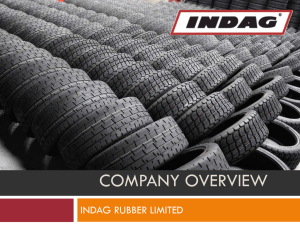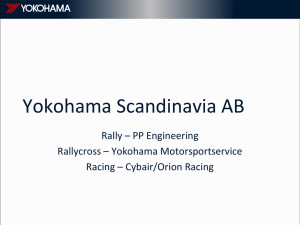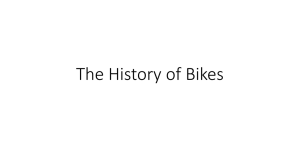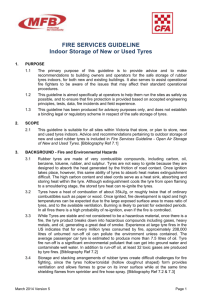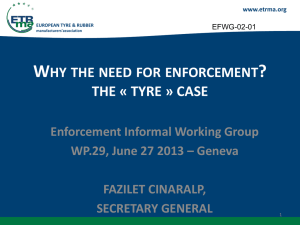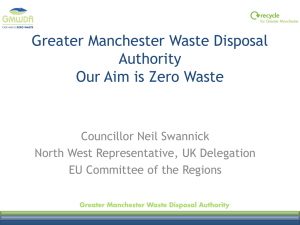Cracking Energy Machines
advertisement
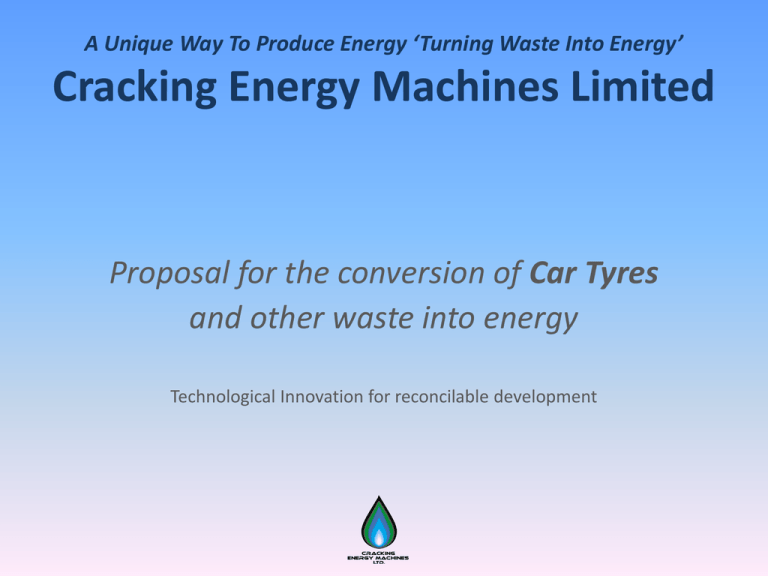
A Unique Way To Produce Energy ‘Turning Waste Into Energy’ Cracking Energy Machines Limited Proposal for the conversion of Car Tyres and other waste into energy Technological Innovation for reconcilable development Cracking Energy have created a patented process Thermodynamic Cracking The process of ‘thermodynamic cracking’ breaks down complex organic molecules or hydrocarbons into simpler molecules by breaking the carbon-carbon bonds; i.e. the breakdown of long chain hydrocarbons to shorter ones. The process is for materials that become viscous during processing through heat and friction, such as plastics and tyres. No harmful emissions are produced and the capital cost of the plants support commercial operation. Why are we unique? Thermodynamic cracking is not Pyrolysis; cracking enables a complete decomposition of plastics/rubber or RDF without any emissions into the atmosphere (see Appendix I) It is an extremely commercially viable solution that can take many different materials as input to produce combustible hydro carbons (see Appendix III) We believe that no-one else has these particular technologies How does it work? Transforms synthetic resins and rubber into combustible hydrocarbons The plastics or rubber are degraded and fed into a horizontal, dual cylindrical reactor which Is devoid of oxygen. Specially shaped rotors generate friction Externally, heating bands provide additional heat. How does it work?.... continued The high temperature generated, together with lack of oxygen inside the reactor, causes molecular cracking of the compound and the formation of organic products made up of carbon molecular chains bonded to other H2 molecules. These products are analogous to natural hydrocarbons; in these conditions, the formation of both dioxin and oxidation products is impossible. Ouputs for different materials TYPE OF MATERIAL Steel Gas Diesel fuel Carbon Ash Automotive tyre Rubber 20 % 15-20 % 25-55 % 25-40 % 0% Heterogeneous plastic materials - 40-50 % 30-40 % 10-15 % 1-2 % Other refuse derived fuels - 30-50 % 20-30 % 10-20 % 5-10 % 6 The Environmental Problems Automotive Shredder Residue (ASR) Car Fluff End of Life Tyres (ELT) •Rigid Plastics 7 End of Life Tyres • The Facts • Over 3 billion tyres are discarded worldwide each year • In the European Union 250 million tyres are accumulated each year expected to rise by 4% per annum (EU Statistics & Freedonia Report) • European Landfill Directive (199/31/EC) states that whole tyres were banned from landfill in 2003 and shredded tyres in 2006 • Piled tyres may trap water, becoming breeding grounds for mosquitoes and bacteria, or they can present a fire hazard • Tyres not in controlled environments have adverse effect on local water courses • Stockpiled tyres can easily combust causing long term smouldering generating toxic smoke that impacts on the environment and local communities • Tyres are very difficult to recycle profitably • Governments and Industry are keen to find a commercially viable solution Environmental Directives • • • • • • EU Member States will be responsible for their own waste recycling U.K. Government reviewing what can & cannot be landfilled Plastic is under review with regard to landfill Land Fill Tax Escalator Extended to 2014 Increase by £8 per tonne per annum to £80 Stricter Controls on level of End of Vehicle Recycling The Perfect Response • The Landfill Directive represents a step change in the way we dispose of waste in the EU • The CEML process is the perfect answer to EU directives by creating a “Virtuous Cycle”, a closed loop recycling process • An Environmentally Friendly solution that reduces the Carbon footprint effectively End of Life Tyres •End of Life Tyres UK •In the UK we produce 46,000,000 used tyres per annum •Used tyres from cars equates to 27,000,000 per annum •The above totals balance to 100,000 tyres per day taken off vehicles that have to be recycled. •In weight there is 450,000 tonnes to reprocess •It is expected that Vehicle ownership will increase between 30 to 40 %. Volume of tyres in tonnes Austria Belgium Denmark Finland France Germany Greece Ireland Italy Luxemburg Netherlands Portugal Figures from Environment Agency Spain Sweden UK Source: ETRA – Introduction to Tyre Recycling 2004 10 In the European Union 55 million discarded tyres are recycled every year! How? 11 Tyre Recycling Options Recycling through microwave technology Breaks the tyres into their original components, the grade A steel can be sold for recovery, the carbon and oil are also reusable. Recycling through grinding Used in sports and play surfaces, brake linings, landscaping mulch, carpet underlay, shoe soles and absorbents for waste. Energy Recovery Tyres have a high calorific value, about 20% higher than coal, which on burning can be harnessed to produce energy. Recycling through cryogenic fragmentati on Used for athletics tracks, carpet underlay, playground surfaces and rubberised asphalt for road surfaces. Energy Recovery through pyrolysis A self contained process which avoids the release of large volumes of combustion gases. Recycling through devulcanisation Can be used to replace part of the virgin material in automotive and cycle tyres, conveyor belts and footwear. Energy Recovery through incineration in cement kilns 12 An Environment Friendly Solution • • • • No Emissions Minimal operational noise A Completely Clean Process Reduced planning permission requirements • Output Fuels meets Strict EU Standards • No requirement to stockpile Large Volumes of Feedstock's • Reduces Carbon Footprint Substantially That is Economically Viable • • • • Gate Fees Sale of Energy Sale of Scrap Steel Sale of Carbon Black What revenue could the use of a tyre cracking plant attract? Tyre Disposal Scrap Steel Gas or Electricity Diesel or Electricity Carbon Black Renewable Energy Certificates Carbon Credits 14 Using the example of scrap tyres, the input/output from the plants, assuming 350 days per year Outputs Inputs Shredded rubber or pellets from car tyres ton/PA MWh Carbon (solids) produce d 23% Quantity of gas ton/pa 15% Quantity of diesel ton/pa 52% MWhr achievable from the gas and diesel pa MWhr for export pa Generator size C750 5,900 3,320 1,357 885 3,068 16,602 13,282 1 x 2,000 KVA 1 x 600 KVA C750/2 11,800 6,640 2,714 1,770 6,136 33,205 26,565 5 x 1,000 KVA 1 x 600 KVA C1500/ 2 25,200 14,18 3 5,796 3,780 13,104 70,913 56,730 5 x 2,000 KVA 1 x 800 KVA Plant 15 How does that compare? For a 40,000t pa plant CEML Competitor’s Pyrolysis Capital cost (complete plant, less connection and land) €30m €30m Output MW Output MW/h 11.8 MW 99,500 MWh 3.4-1.5 = 2.9MW 22,970MWh Space required 1,500-2,300sqm 1,500-2,300sqm 0% NOx 38% SO² 34% Dioxin 2% Noxious gases as a percentage of EU limits The real difference is the result of molecular cracking rather than burning 16 The Environmental Problem Automotive Shredder Residue (ASR) Car Fluff End of Life Tyres (ELT) •Rigid Plastics 17 End of Life vehicles (ELT) The End of life Vehicle directive (2000/53/EC) is the framework of disposal and has been adopted by the UK Government • In Europe 9,000,000 tonnes of ELV’s arise each year • In the UK there are approximately 2 million tonnes ELV’s per year currently • 400,000 are premature i.e. scrapped due to Accidents (17%) • 1.5 million are natural ELV’s disposed responsibly (71%) • 200,000 are abandoned(11%)1% • equates to illegal parts resulting from stolen vehicles European Legislation Directive 2000/53/EEC • The Directive aims to decrease the quantity of waste arising from vehicles by weight • The rate of re-use and recovery: • 85% no later than 1 January 2006 • 95% no later than 1 January 2015 • Vehicles built prior to 1980 have different targets. • There are key processes that ELV’s are subjected to prior to final breakdown Figures from Tri study report - DEFRA 18 End of Life Vehicles The diagram below shows the various materials from a vehicle 19 End of Life Vehicles • End of life vehicles have to be processed via an Authorised Treatment Facility • Recycling processes are sophisticated delivering a large volume of product • Car Fluff has been filtered to a very fine degree however there is plastic left that cannot be recycled • Non recycled plastic goes to landfill incurring a substantial cost • Current charges are £56 per tonne rising by £8 per annum through to 2014 20 An Environment Friendly Solution to Car Fluff Waste Cracking Energy Machines Ltd • No Emissions • Minimal operational noise • Reduced planning permission requirements • Output Fuels meets Strict EU Standards • No requirement to stockpile Large Volumes of Feedstock's • Reduces Carbon Footprint Substantially Economically Viable • No fees to landfill • Sale of energy • Using a totally non recyclable waste 21 The Environmental Problem End of Life Tyres (ELT) • Rigid Plastics Automotiv e Shredder Residue (ASR) Car Fluff 22 Rigid Plastics There are a range of different plastics that can be recycled; in order to assist recycling they are marked with an agreed code located in the recycling triangle Recyclable Rigid Plastics • • • • • • • PET – Polyethylene Terephthalate – Code 1 HDPE – High Density Polyethylene – Code 2 PVC – Polyvinyl Chloride – Code 3 LDPE – Low Density Polyethylene – Code 4 PP – Polypropylene – Code 5 PS – Polystyrene – Code 6 Other Plastics – Code 7 23 Relative Occurrence 24 UK Plastic Waste Volumes The most recent review of UK plastic waste volumes was carried out in 2006 by WRAP 25 Global Volumes The global consumption of plastics is over 200 million Tonnes pa and growing. Based on the experience of several European countries with a strong domestic recycling activity; from a technical perspective is would seem practical for well over 20% of global consumption to be met by recycled plastics – at least 40 million Tonnes pa. 26 CEML Technology CEML Technology • CEML’s thermodynamic cracking technology can use waste plastic as a feedstock. After transformation, the waste plastic is converted into:• Diesel that complies with specification EN: • Liquefied Petroleum Gas (LPG – Propane) that complies with EN: 27 The input/output characteristics of the CEML C750 and C1500 machine using plastic as a feedstock are as follows; Input Output Data Sheet – typical mixed plastics Machine Configuration INPUT – Typical Mixed Plastic Volumes of plastic shreds per hour - kg/hr Assume 24 hours operation – Tonnes/day Assume 350 days pa Operation - Tonnes pa OUTPUTS - Percentage by weight Diesel Gas Carbon Ash OUTPUTS – Weight and volume Diesel weight, kg/hr Diesel volume, Litres/hr Diesel volume, Litres/pa C750 C750/2 C1500 C1500/2 700 16.8 5,880 1,400 33.6 11,760 1,500 36.0 12,600 3,000 72.0 25,200 35% 45% 19% 1% 35% 45% 19% 1% 35% 45% 19% 1% 35% 45% 19% 1% 245 288 2,421,176 490 576 4,842,353 525 618 5,188,235 1,050 1,235 10,376,471 Propane Gas weight, kg/hr Propane Gas volume, m³/hr Propane Gas volume, m³/pa 315 420 3,528,000 280 147 1,237,895 300 158 1,326,316 600 316 2,652,632 Carbon weight, kg/hr Carbon weight, kg/pa 133 1,117,200 350 2,940,000 375 3,150,000 750 6,300,000 28 Input Output Data Sheet – typical mixed plastics C750 Cracking machine efficiency Cracking machine power demand, kW inc processing? Total available diesel generation – gross kW Total available gas generation – gross kW Total available net export power ekW 81% 89 1,383 1,680 2,974 29 Appendix I – Emissions from Pyrolysis versus Cracking Pyrolysis Cracking ton/day Kg/s Kg/s Incoming Refuse Derived Fuels (RDF) 72 0.83 0.83 Air input 395 4.58 0 CO2 emission 121 1.4 0 N2 emission 312 3.6 0 H2O emission 38 0.43 0 Total volatiles emission 470 5.4 0 Solid residue 2.16 0.025 0 Based on plants that handle 72 tons of RDF per day 30 Appendix II – composition of fuel and testing • Liquids – Tested to EN590:2009.01 – EN590 describes the physical properties that all automotive diesel fuel must meet if it is to be sold in the EU, Iceland, Norway and Switzerland – It allows for blending up to 5% Biodiesel for a 95/5mix – Tested to EN14214. The standard for Biodiesel • LPG – Tested to BS EN 589:2008 – BS EN 589:2008 specifies requirements and test methods for marketed and delivered automotive LPG (Liquefied Petroleum Gas) • Carbon Black – Tested to BS ISO 6209:2009 – The standard for Rubber compounding ingredients Appendix III – Other Materials We Can Process Material Examples Polypropylene Food containers, particularly those that need to be dishwasher safe Polythene Shopping bags Polycarbonate Sports bottles, baby bottles, food containers Polystyrene Disposable cutlery, CD & DVD cases, smoke detectors Natural rubber Rubber bands, hoses, elastic, wetsuits Synthetic rubber Bicycle tyres, car dashboards, shoes Scraps from leather industry Diaries, bags, belts, chairs Organic matter Wood, vegetables, vegetation Polyurethane Drainpipes, luggage, non food packing % of output depends on materials used 32 Appendix IV Input Output Calculator - Based on Tyres 750 750/2 1500 1500/2 INPUTS Volumes of rubber shreds per hour - Kg/hr 700 1,400 1,500 3,000 Assume 20% of tyre is steel - rubber and steel 875 1,750 1,875 3,750 97 194 208 417 816,667 1,633,333 1,750,000 3,500,000 7,350 14,700 15,750 31,500 Assume each car tyre is 9kg - Tyres per hour Assume 350 days pa Operation - Tyres pa Assume 350 days pa Operation - Tonnes pa Percentage by weight output Diesel Gas Carbon Black 55% 20% 25% 55% 20% 25% 55% 20% 25% 55% 20% 25% OUTPUTS Diesel Litres/hr 453 906 971 1,941 Diesel Litres/pa 3,804,706 7,609,412 8,152,941 16,305,882 Gas Volume/hr - M3 74 147 158 316 Gas Volume/pa - M3 618,947 1,237,895 1,326,316 2,652,632 Carbon Black Kg/hr 175 350 375 750 Carbon Black Kg/pa 1,470,000 2,940,000 3,150,000 6,300,000 33 Appendix V Electricity Generation. Assume 1 litre of Diesel will produce 4.8KWhr Assume 1cubic meter of gas will produce 4KWhr Assume generation powerfactor 0.8 0.8 0.8 0.8 Machine efficiency 81% 83% 88% 89% Machine load- KW 469 839 635 1,164 2,174.12 4,348.24 4,658.82 9,317.65 294.74 589.47 631.58 1,263.16 Total 2,468.85 4,937.71 5,290.40 10,580.80 eKW to export from generator - KW 1,975.08 3,950.17 4,232.32 8,464.64 Output power after machine loading - KW 1,506.00 3,110.76 3,597.47 7,300.76 Diesel generated Power Gas generated Power 34 Contact Cracking Energy Machines Ltd The Office Building Gatwick Road Crawley West Sussex RH10 9RZ Tel: +44 (0) 1293 847480 info@ceml.eu www.ceml.eu UK Agents Harman Martin Ltd Robin Martin 07967 233062 Steve Harman 07528 208387
